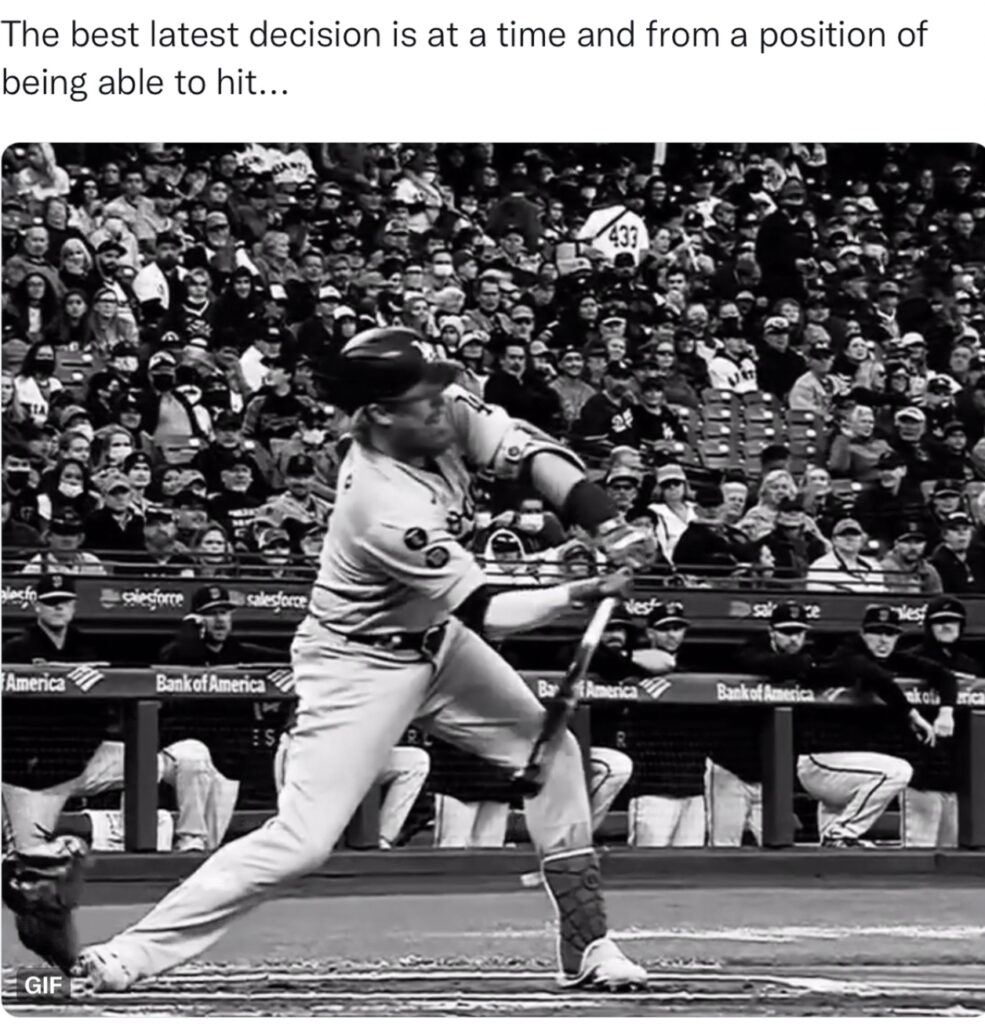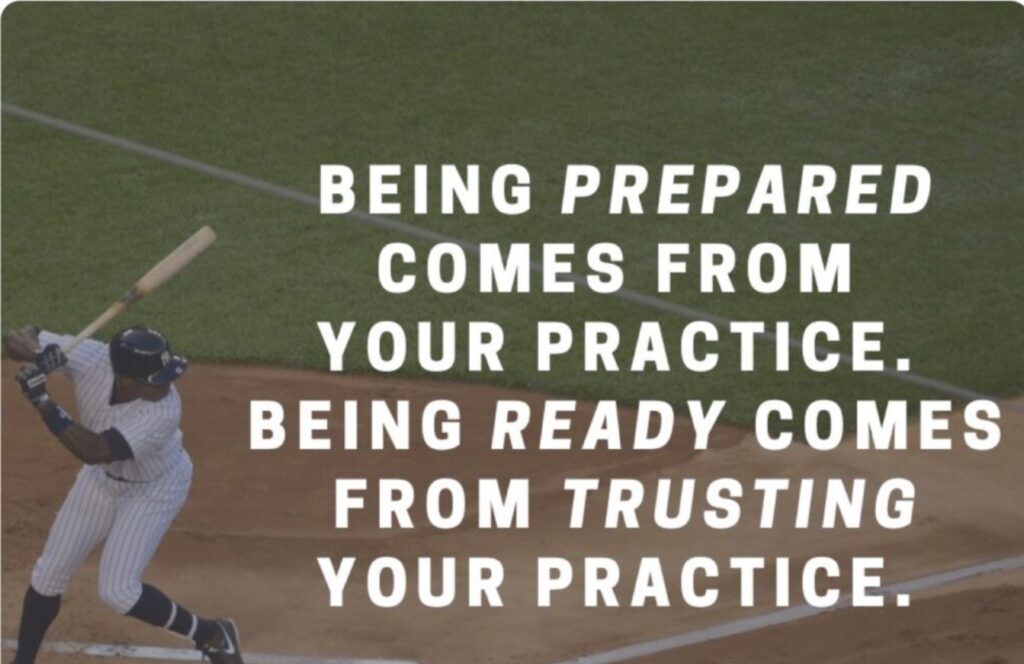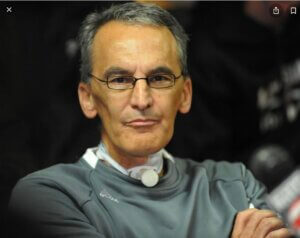
The hitting challenge is essentially a ”timing challenge” that involves the skills of PITCH RECOGNITION, IMPULSE CONTROL & MOTOR PROGRAMMING in order to be successful.
The genius of human adaption to hitting 100 m.p.h. 4 seam fastballs followed by a nasty 85 m.p.h. slider followed by a chase slider then another 100 m.p.h. 4 seam again painted on the inside black is great quickness & acceleration, referred to as RATE OF FORCE DEVELOPMENT. Rate of force development for an elite hitter in baseball/softball is .12 to .14 hundreds of a second with great accuracy & power.
The best hitters I’ve studied and been around have BOTH great power and great consistency/batting averages — & GREAT EYES (PITCH DISCIPLINE).

- I LOOK FOR NOTHING & SEE EVERYTHING;
- I SEE the spin of the ball & the direction of the seams;
- I SEE the ball and then let my hands do the rest;
- Everything goes black; I black out & really don’t recall what I see;
- I see, hear & smell EVERY detail; every single little detail.
In reality, most players are not accurate historians. They explain it the best they know how.
Science tells us, it is an ongoing “refinement of anticipation” — “feed forward” — THINKING FAST — where the brain and peripheral nervous system constantly compares ”IMAGES” of
- (1) what is expected based on past experiences, compared to
- (2) real time sensory input.
There is basically no time for sequential execution of all of the tasks that are necessary for pitch recognition and swing execution — THINKING SLOW. That’s why we continue to discuss IMPULSE CONTROL & MOTOR PROGRAMMING: how we compress these many events and use ideas such as pitch discipline, hunting pitches, guessing, anticipating, sitting on a pitch, etc.
There is value in a hitting approach & plan — PITCH DISCIPLINE (versus ”swinging at strikes”).
In fact, the goal of practice is to have your swing automated within the context of THE HITTING PLAN so you can just ”see the ball & hit the ball”, but that takes LOTS of game experience, simulated practices and precise protocols.
In order to TRUST YOUR EYES and get rid of any conscious thought processes (THINKING SLOW) interfering with your swing and only using your ambient visual system & swing when the right pitch shows up (THINKING FAST) — that motor program has to be already prepared from deliberative practice and lots of game opportunities.

In order to meet the “timing challenge”, hitters should continue to develop their skills of PITCH RECOGNITION, IMPULSE CONTROL & MOTOR PROGRAMMING.
Hitters continue to grow and learn to develop & create better quickness/acceleration – RATE OF FORCE DEVELOPMENT & better accuracy. That’s part of the process of ADAPTING to the challenge of hitting against elite pitchers — continued SKILL DEVELOPMENT with a growth mindset that seeks solutions best suited to accomplish the task.
Great hitters have to be able to hit with great power and great consistency/batting averages.
The human body/mind does NOT prosper when forced to choose EITHER/OR or only afforded binary choices. When the challenge is greatest, some creative soul with a growth mindset comes up with a “3rd way” or a “new solution” or a “better option” that transcends the status quo. Status quo &/or mediocrity are the result of dead ends of either/ors.
Seek out these solutions and use them to reach your potential. NO LIMITS!
Hitting is timing and pitching is trying to cross up a hitter’s timing.
One of the primary requirements of hitting is to minimize timing errors via IMPULSE CONTROL.

Good timing and impulse control results in good bat speed at great rate of force development at contact.
The main source of error in ”SWING DESIGN” (MOTOR PROGRAMMING) to combat ”PITCH DESIGN” is calculating swing duration – and getting trapped into the binary choices only involving PATH (launch angle) and POWER (bat speed).
SWING DURATION is KEY: (bat head launch to contact): IMPULSE CONTROL is KEY. It is not & should never be a tradeoff between path/power or accuracy/consistency.
The perfect swing is about ”adjustability” – matching the plane of the swing to the pitch you were anticipating and are swinging at & BEING ON TIME without compromising power.
Hitters must have or develop a mechanism in their swings that allow them the adjustability to transfer from coil to rotate on demand without effecting their swing duration.
Creating a ”buffer” to combat a pitcher’s change in linear speeds does not involve SLOWING DOWN YOUR SWING nor starting the launch at toe touch or heel strike every time regardless of where the ball is.
IMPULSE CONTROL & MOTOR PROGRAMMING allow a hitter to create maximum force & transfer all of the energy accurately to drive the ball.
If the pitch is a fastball or velocity on the inside part of the plate, then the hitter needs to apply his/her impulse force ASAP. The hitter transitions from coil to rotate early and probably starts his/her rotation before toe touch. If the pitch is an off-speed, the force is applied later.
Hitters have to be prepared to adjust and apply force at different moments based on what his/her EYES RECOGNIZE on the pitch, &/or based on his/her swing plan/approach.
The biomechanical solution must include mechanics that involve early bat speed (rather than dead hands and an ”A to B” type barrel path), and late adjustability, including IMPULSE CONTROL to trust your eyes and stop your swing ”late” like Justin Turner demonstrates below.

The longer you can continue to load & coil and move the middle then the longer you can gather information by reading/recognizing the pitch. Said another way, the greater your rate of force development and the shortest amount of time it takes to ”execute your best swing”, then the longer you can continue to load & coil and move the middle while gathering information on the incoming pitch.
The hitters having the most success are using the combination of great pelvis loading and tempo, great, consistent plans/approaches, & rapid rates of force development (R.F.D.). PITCH RECOGNITION, IMPULSE CONTROL, MOTOR PROGRAMMING. It is a combination of multiple skills and the perfect execution by very talented athletes.
R.F.D. and good IMPULSE CONTROL allows the hitter to ”wait” on his/her pitch (YOUR PITCH) which enhances ”read TIMING” – PITCH RECOGNITION: a.k.a TRUSTING YOUR EYES!
HAVE YOU PREPARED ENOUGH TO TRUST YOUR EYES?

PURSUE EXCELLENCE & WIN THIS PITCH!
About the Author

Mike Lotief coached 17 successful years as either the head softball coach or co-head softball coach with his wife Stefni Whitton Lotief at the University of Louisiana from 2002-2017 with an overall coaching record of 731-176 (80.6 winning percentage). Every season, the Ragin Cajuns softball team advanced to the NCAA tournament and also advanced to three (3) Women’s College World Series (2003, 2008, 2014) and from 2012-2016 advanced to five (5) straight NCAA Super Regionals. Coach Lotief produced over 40 All American selections and his 2017 team lead the nation in scoring and was ranked in the Top 10 in home runs, slugging percentage, on base percentage.
The coach is a cancer survivor (twice) and was the first person in the U.S. to receive the Pro Trach device. Mike and Stefni spearheaded and raised the funding to build the new softball stadium in 2009 and the new softball indoor hitting facility in 2015. They are proud parents to Chelsea, who played softball and graduated from the Univ. of Louisiana in 2018, and Andrew, who is a junior at Louisiana studying Mechanical Engineering.
Previous Articles in this Series
- The Mental Swing Attractors: Failure Cannot Break You (Nov. 11, 2021)
- Training Insights: “Swing Attractors” by Coach Mike Lotief… the Flaws of Pelvic Loading (Nov. 9, 2021)
- The Mental Swing Attractors: Push Yourself… You Don’t Have to Be #1 to BE #1! (Nov. 4, 2021)
- Training Insights: “Swing Attractors” by Coach Mike Lotief… Pelvis Loading, Part 2—The Planes of Movement (Nov. 2, 2021)
- The Mental Swing Attractors: Remove the Rope from Your Ankle & Get Rid of the Limiting Beliefs! (Oct. 28, 2021)
- Training Insights: “Swing Attractors” by Coach Mike Lotief… Pelvis Loading, Part 1—It’s All in the Hips (or Somewhere Deep Below) Oct. 26, 2021
- The Mental Swing Attractors: Champions are Developed by Devotion & Discipline! (Oct. 21, 2021)
- Training Expertise: “Swing Attractors”… the Secrets of Power Hitting by Coach Mike Lotief (Oct. 19, 2021)
More About Mike Lotief
- Why Michael Lotief is a Legendary Coach? by Jay Patel
- The Secret To Michael Lotief’s Success. By Jay Patel
- Michael Lotief Fights for Rajin’ Cajuns by Graham Hays ESPN
- Michael Lotief: Taking His Sport to New Heights by Neha Kapoor
- For the Love of the Game: A Look at Ragin’ Cajun Softball’s Power Couple
- How Louisiana-Lafayette’s Michael Lotief Develops Hitting Gems by Graham Hays ESPN
